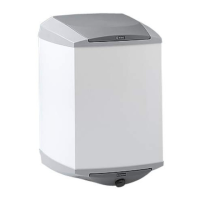INSPECTION OF THE INSTALLATION
Current regulations require the heating installation to be inspected before it is commissioned. The inspection must
be carried out by a suitably qualified person.
DateSigna-
ture
NotesDescription
Hot water (page 8)
Shut off valves
Cold water (page 8)
Shut off valves
Non-return valve
Mixing valve
Safety valve
Electricity (page 7)
Connected supply
User manual
MAINTENANCE
SAFETY VALVE (NOT ENCLOSED)
The safety valve (FL1) must be inspected regularly, about
4 times a year, to prevent clogging. The check is made
by turning the safety valve’s knob anticlockwise, water
should then flow through the overflow pipe. If this does
not happen, then the safety valve is defective and must
be replaced.
The safety valve sometimes releases a little water after
hot water has been used. This discharge is caused by
the expansion of cold water entering the water heater,
resulting in a pressure increase, whereby the safety
valve opens.
EMPTYING
1.
Turn off the power to the water heater.
2.
Shut off the cold water inlet with valve QM35).
3.
Drain the water heater via the safety valve (FL1) or
by disconnecting the cold water connection (XL3).
4.
During draining, air must be supplied to the water
heater by opening some hot water taps, preferably
the closest and lowest. If this is not sufficient, dis-
connect the hot water connection (XL4).
NOTE
Hot water can splash when draining and cause
personal injury
A small amount of water may remain at the bottom of
the water heater after completion of the described
draining stages.
When installed in a location where there is the risk of
frost, the water heater must be drained when it is not
in operation. Freezing could result in the water heater
cracking and causing water damage.
5NIBE Eminent Exp | GB

